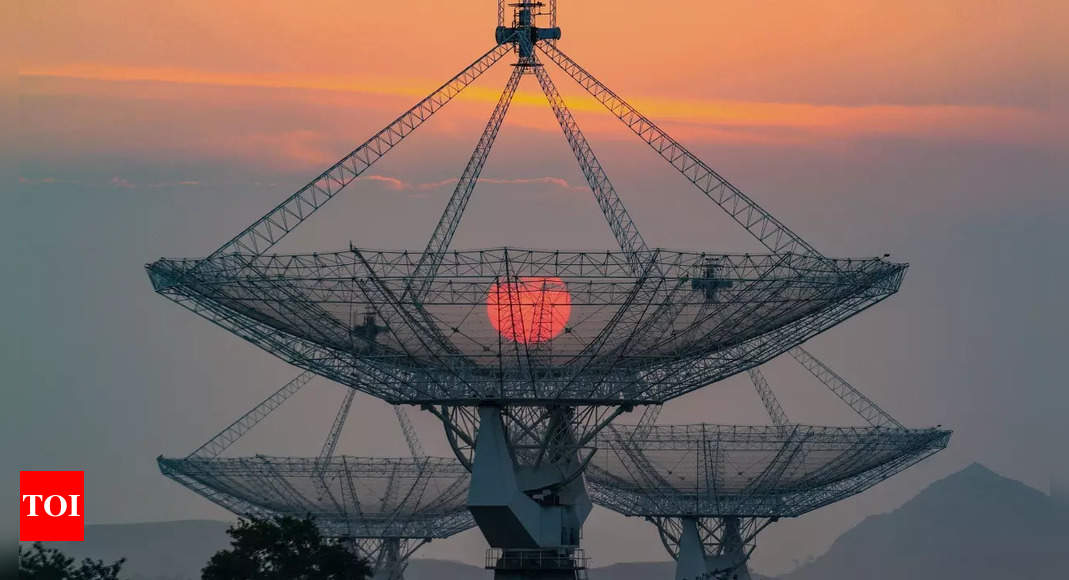In a major breakthrough, a global team of astronomers that included scientists from seven Indian institutes have, for the first time, heard the low-pitch “hum” of gravitational waves reverberating across the universe, the existence of which was predicted by Albert Einstein. India’s upgraded Giant Metrewave Radio Telescope (uGMRT) near Pune was one of the world’s six most sensitive radio telescopes that played a key role in discovering the persistent hum. The gravitational waves (GW) are thought to have originated from the merger of super-massive black holes in the early universe, soon after the Big Bang. With this discovery, scientists hope to learn more about physical reality and answer mysteries about the nature of merging super-massive black holes and what brings them together. The findings, reported in a series of papers in The Astrophysical Journal Letters on Thursday, come from 15 years of observations made by North American Nanohertz Observatory for Gravitational Waves (NANOGrav) with more than 190 scientists, including from Indian Pulsar Timing Array (InPTA) that used uGMRT. The Indian telescope was used to collect and correct the signal and increase the accuracy of the signal so that it could corroborate the “hum” of the universe, as detected by their European counterparts. The first experiment of the pulsar timing array started in 2002 and InPTA got involved in 2016. The InPTA experiment involves researchers from NCRA (Pune), TIFR (Mumbai), IIT (Roorkee), IISER (Bhopal), IIT (Hyderabad), IMSc (Chennai) and RRI (Bengaluru) along with their colleagues from Kumamoto University, Japan. Gravitational waves were first proposed by Einstein in 1916 but were not directly detected until about 100 years later when the National Science Foundation-funded LIGO in 2016 picked up the waves from a pair of distant colliding black holes. However, LIGO detected gravitational waves that were much higher in frequency than those registered by NANOGrav. Bhal Chandra Joshi of NCRA-TIFR, Pune, who founded the InPTA collaboration during the last decade, said, “According to Einstein’s theory, gravitational waves change the arrival times of these radio flashes and thereby affect the measured ticks of pulsars which are also called our cosmic clocks. But there was no discovery of this change till now. These changes are so tiny that astronomers need sensitive telescopes like the upgraded GMRT and a collection of radio pulsars to separate these changes from other disturbances. The slow variation of this signal has meant that it takes decades to look for these elusive nano-hertz gravitational waves.” The first experiment of the pulsar timing array started in 2002 and InPTA got involved in 2016. The InPTA experiment involves researchers from NCRA (Pune), TIFR (Mumbai), IIT (Roorkee), IISER (Bhopal), IIT (Hyderabad), IMSc (Chennai) and RRI (Bengaluru) along with their colleagues from Kumamoto University, Japan. Explaining the event, Mayuresh Surnis, assistant professor at the Bhopal-based Indian Institute of Science Education and Research, said, “If you convert the GW to sound, the background detected could be called a hum. The background is made by superimposition of the GW caused by many sources which are supermassive black hole binaries. Once we analyse the data more, we will be able to say what kind of blackholes they were. We have detected the GW in low frequency and LIGO has done so in high frequency. So we are trying to find the entire spectrum of the GWaves.” Yashwant Gupta, centre director at National Centre for Radio Astrophysics (NCRA), Pune, which operates the uGMRT, said, “It is fantastic to see our uGMRT data being used for ongoing international efforts on gravitational wave astronomy. Scientists of the European PTA in collaboration with the Indo-Japanese colleagues of the InPTA have reported detailed results of analysing pulsar data collected over 25 years with six of the world’s largest radio telescopes. This includes more than three years of very sensitive data collected using the unique low radio frequency range and the flexibility of India’s largest radio telescope – the uGMRT.” He added, “The signal we are trying to extract from pulsars (dead stars) is very faint. The signal is distorted when it passes through the medium of a galaxy. To correct this signal, a low-frequency telescope like the GMRT is required. Once the signal is cleaned, the accuracy of the signal increases, helping the scientists using GMRT, to detect the low-frequency gravitational waves causing it.” Discovery In A Nutshell: Q. Where do gravitational waves come from? * Supermassive black holes in almost all galaxies weigh several million to many billion times the mass of the Sun. When galaxies merge, black holes are also expected to merge after a long spiral dance. Merging black holes emit gravitational waves Q. What is humming? * When black holes merge across the universe and in every direction, these waves overlap and form a background hum of gravitational waves. This thrumming hum is called stochastic gravitational wave background Q. What are pulsars? * Pulsars are rapidly rotating compact dead stars which emit bright beams of radio light from their poles Q. Pulsar Timing Array Some millisecond pulsars rotate 100 times a second without missing a beat. Scientists observe an array of millisecond pulsars to keep accurate time. Hence, the experiment is called a pulsar timing array. Gravitational waves interact with pulsars, stretching and squeezing space-time which causes changes in the time of arrival of the pulses to Earth Q. What next? Deeper understanding of the nature of current signals. Detecting individual merging binaries at the cores of the galaxy. With the detection of individual binaries, we will be able to detect distances to these mergers, and predict the expansion rate of the universe at an early epoch











